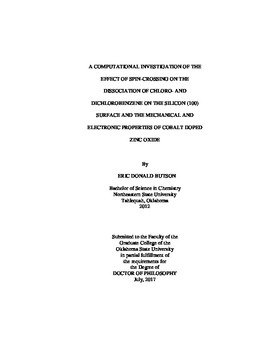| dc.description.abstract | The adsorption and dissociation of chlorobenzene and dichlorobenzene on the Si(100) surface was modeled using hydrogen terminated silicon clusters within the density functional theory framework. Using single dimer to much larger clusters, containing up to four surface dimers, to model multiple Si-dimer rows on the Si(100) surface, the adsorption energy and potential dissociation pathways were investigated on singlet and triplet surfaces. After a systematic study of possible chlorobenzene adsorption geometries, including analogs generated from benzene adsorption geometries, and their possible dissociation products, the 1,2-tilted, 1,4-butterfly, and row-linking butterfly structures were found to be the most energetically favorable starting structures for dissociation. Similar results were found with dichlorobenzene, with the 2,3-tilted, 1,4- butterfly and row-linking butterfly structures being the only feasible starting structures for 1,2-dichlorobenzene, and the 1,2-tilted and 1,4-butterfly structures being the only feasible starting structures for 1,4-dichlorobenzene. In all cases, the dissociation pathway required intermediates in the triplet state. The necessity of a spin-crossing event was found to have a minimal effect on the energies of the dissociation pathways. In all cases, no more than 20% of the adsorption structures lead to dissociation; these results are consistent with experimental investigations which show little to no dissociation of chlorobenzene and dichlorobenzene. In addition to this work, the effects of cobalt doping on the optical properties of zinc oxide were studied. Most work in this area has focused on the magnetic properties of Co-doped ZnO, as it is predicted to have a Curie temperature around room temperature, making it desirable for spintronics. As a first step, pseudopotentials were developed and used to calculate the bulk modulus. These results were compared to other experimental and theoretical data. | |
